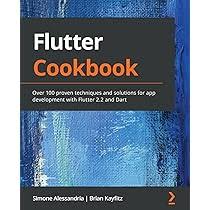Flutter Cookbook: A White Paper
1. Introduction
Flutter, Google's open-source UI toolkit, has gained significant traction for building natively compiled applications for mobile, web, and desktop from a single codebase. This white paper explores key concepts and use cases of Flutter, drawing insights from "Flutter Cookbook" by Antonio Meli.
2. Core Concepts
- Dart: Flutter utilizes the Dart programming language, known for its fast performance and object-oriented nature.
- Widgets: Flutter's fundamental building blocks are widgets, which are immutable and declarative. This approach leads to highly performant and maintainable user interfaces.
- Hot Reload: Flutter's hot reload feature allows developers to see changes to their code reflected in the running application almost instantly, significantly accelerating the development process.
- State Management: Flutter provides various state management solutions, including StatefulWidget, Provider, BLoC (Business Logic Component), and Riverpod, to effectively manage data flow and application state.
- Platform Channels: Enables communication between Flutter code and native platform-specific code (e.g., accessing device-specific features like camera or GPS).
3. Key Features
- Cross-platform Development: Develop applications for iOS, Android, web, Windows, macOS, and Linux from a single codebase, reducing development time and costs.
- Expressive and Flexible UI: Build visually appealing and performant user interfaces with a rich set of customizable widgets.
- Excellent Performance: Flutter compiles to native code, resulting in smooth and fluid user experiences.
- Large and Growing Community: A vibrant community provides extensive support, readily available resources, and a wealth of third-party packages.
- Open-source and Free: Flutter is an open-source project with no licensing costs, making it accessible to developers of all levels.
4. Use Cases
- Mobile App Development:
- Build high-performance, visually appealing mobile applications for both iOS and Android.
- Ideal for a wide range of applications, including social media apps, e-commerce platforms, productivity tools, and games.
- Web Applications:
- Develop interactive web applications with a native-like look and feel.
- Create progressive web apps (PWAs) that offer an enhanced user experience.
- Desktop Applications:
- Build cross-platform desktop applications for Windows, macOS, and Linux.
- Extend mobile applications to desktop environments seamlessly.
- Embedded Systems:
- Utilize Flutter for developing user interfaces for embedded devices with limited resources.
5. Conclusion
Flutter has emerged as a powerful and versatile framework for building high-quality, cross-platform applications. Its focus on performance, developer experience, and a rich ecosystem makes it an excellent choice for a wide range of projects. "Flutter Cookbook" provides practical guidance and recipes for effectively using Flutter, empowering developers to build exceptional user experiences.
References
- Meli, Antonio. Flutter Cookbook. Packt Publishing, 2023.
- Flutter Documentation: https://dart.dev/
Disclaimer: This white paper provides a general overview of Flutter and its capabilities. For detailed information and implementation guidance, refer to the official Flutter documentation and the "Flutter Cookbook" book.
This white paper provides a concise overview of Flutter based on "Flutter Cookbook." Remember to adapt and expand it based on your specific requirements and the depth of information you wish to convey.



